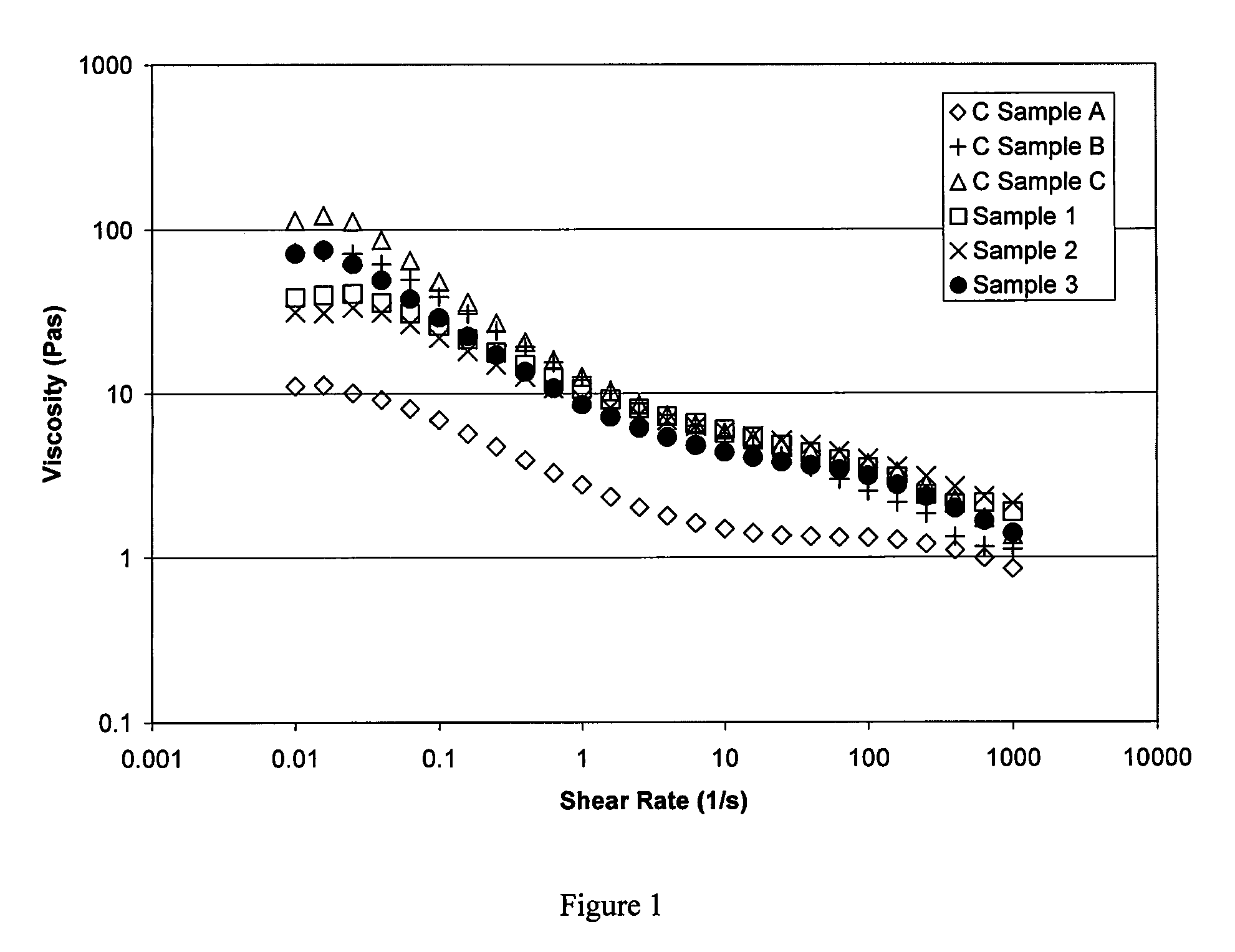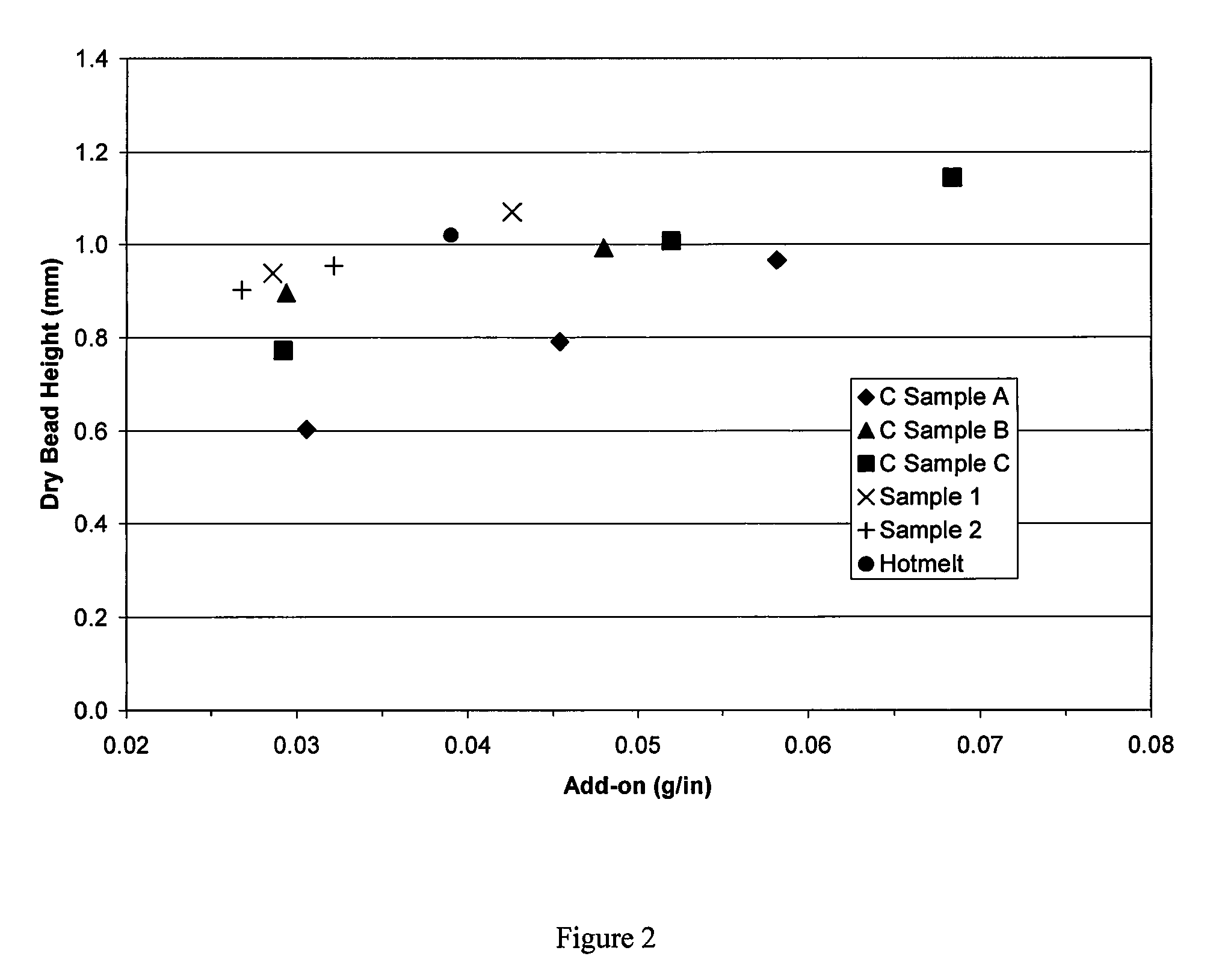Hot melt assist waterborne adhesives and use thereof
a technology of waterborne adhesives and hot melt, which is applied in the direction of adhesive processes using foamed adhesives, transportation and packaging, etc., can solve the problems of low heat resistance, high energy consumption, and melt adhesives, and achieves high amplitude (bead) profiles, fast evaporation, and high amplitude.
- Summary
- Abstract
- Description
- Claims
- Application Information
AI Technical Summary
Benefits of technology
Problems solved by technology
Method used
Image
Examples
example 1
Hot Melt Assist Waterborne Adhesives Components
[0036]Each hot melt assist waterborne adhesive was made by combining the components in Table 1 and then stirring for about an hour or until the mixture became homogeneous.
[0037]
TABLE 1ComponentsC Sample AC Sample BC Sample CSample 1Sample 2Sample 3Sample 4Poly vinyl acetate5042.549.8847.3848.6246.34ethylenepolyvinyl acetate5042.549.8847.3848.6246.3483.06plasticizer9.62rheology modifier0.250.300.30CaCO3 filler15.0microsphere3.053.05135 micron (wet)microsphere4.9955 micron (dry)microsphere2.49135 micron (dry)preservative0.130.130.120.12defoamer0.130.130.120.12water3.733.73MicrosphereN / AN / AN / A30%30%25%25%Volume %
example 2
Rheology Verses Shear Rate
[0038]The rheologies of the above samples were measured against the shear rate, and shown in FIG. 1. Comparative Sample A had the lowest viscosity and therefore had the poorest bead amplitude. The addition of fillers (Comparative Sample B), rheology modifiers (Comparative Sample C), or pre-expanded microspheres (Sample 1, 2, and 3) increased the viscosities of the adhesive. Comparative Samples B and C and samples 1-3 have a reasonable bead amplitude to provide the gap filling properties. Comparative Sample B is not extrudable because the abrasive fillers would damage the extrusion equipment. Comparative Sample C had higher viscosity at lower shear rate than Samples 1-3. Samples 1-3 had acceptable profiles at various shear rates.
example 3
Dry Bead Height
[0039]The dry bead height of each sample was measured. Various add-on levels (Win) of the adhesive was placed on a substrate, dried fully and the amplitude (height) of the bead was measured. For comparison purpose, Henkel's Technomelt SUPRA® 100 hot melt was applied at 0.04 g / in and the height of the cooled bead was measured to be about 1 mm. The dry heights and the add-on levels are shown in FIG. 2.
[0040]FIG. 2 shows that conventional waterborne adhesives such as Comparative Sample A have relatively low dry bead height even at 0.06 g / in add-on levels. While Comparative Sample C had higher viscosity at the tested shear rate, thickening the waterborne adhesive with a rheology modifier failed to form similar height as that of a hot melt adhesive. The addition of fillers in the waterborne adhesive (Comparative Sample B) increased the dry bead height to levels similar to the hot melt amplitude. Also, the addition of microspheres in the waterborne adhesives, Samples 1 and ...
PUM
| Property | Measurement | Unit |
|---|---|---|
| Tg | aaaaa | aaaaa |
| diameter | aaaaa | aaaaa |
| diameter | aaaaa | aaaaa |
Abstract
Description
Claims
Application Information
 Login to View More
Login to View More - R&D
- Intellectual Property
- Life Sciences
- Materials
- Tech Scout
- Unparalleled Data Quality
- Higher Quality Content
- 60% Fewer Hallucinations
Browse by: Latest US Patents, China's latest patents, Technical Efficacy Thesaurus, Application Domain, Technology Topic, Popular Technical Reports.
© 2025 PatSnap. All rights reserved.Legal|Privacy policy|Modern Slavery Act Transparency Statement|Sitemap|About US| Contact US: help@patsnap.com



